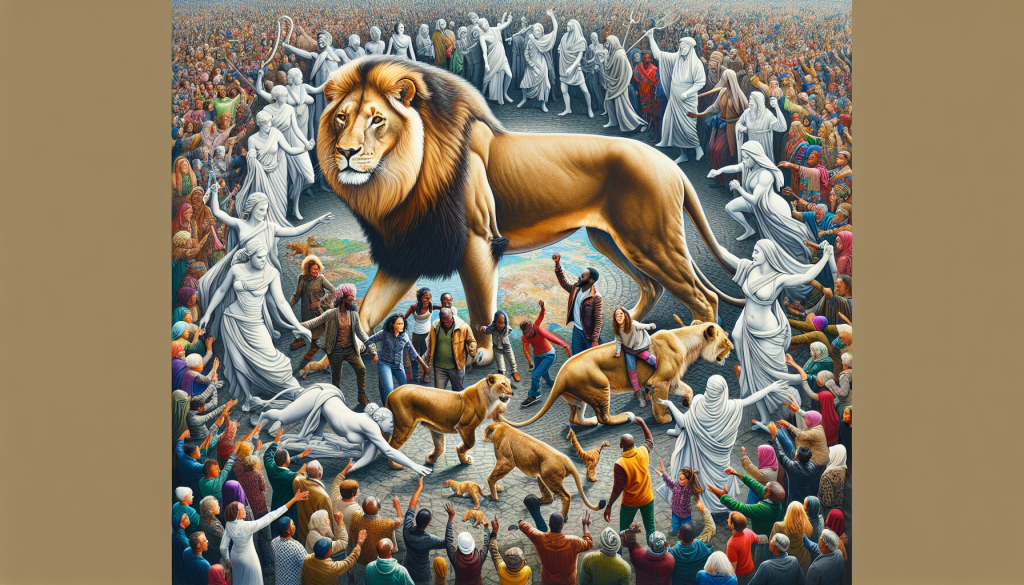Have you ever wondered how different communities around the world collaborate to conserve lions? In this article, we explore the fascinating concept of cultural exchange for lion conservation. From remote villages in Africa to urban neighborhoods in North America, individuals and communities come together to share their knowledge, experiences, and traditions in the common goal of protecting these majestic creatures. Through this exchange, not only are valuable conservation efforts undertaken, but bonds are also forged that unite people across borders and cultures. Join us as we uncover the powerful impact of cultural exchange on lion conservation and the triumphs that arise from collaborative efforts.

Overview
Why cultural exchange is important for lion conservation
Cultural exchange plays a crucial role in the conservation of lions, as it fosters collaboration between different communities and promotes a deeper understanding of conservation efforts. By exchanging knowledge and practices, diverse communities can work together towards a common goal of ensuring the survival of these majestic creatures. Cultural exchange allows for the sharing of sustainable strategies, while respecting the cultural practices and beliefs of each community involved.
Key factors that contribute to successful collaboration
Successful collaboration in lion conservation requires several key factors. Firstly, open and inclusive communication is essential to bridge cultural gaps and foster mutual understanding. Secondly, respecting and valuing the insights, traditions, and knowledge of local communities is crucial for their active involvement in conservation efforts. Lastly, establishing partnerships between conservation organizations and local communities helps create a synergy that enhances the effectiveness of conservation initiatives.
Benefits of cultural exchange for both communities and lion conservation
Cultural exchange brings about numerous benefits for both communities and lion conservation. For communities, it provides opportunities for empowerment and decision-making, ensuring that their voices are heard and their needs are considered. Additionally, cultural exchange can lead to alternative income-generating opportunities through eco-tourism initiatives, promoting sustainable livelihoods. From a lion conservation perspective, cultural exchange facilitates the implementation of innovative conservation strategies by drawing upon the unique cultural practices and beliefs of different communities.
Cultural Diversity and Lion Conservation
Understanding the importance of cultural diversity in conservation efforts
Cultural diversity is vital in conservation efforts, as it harnesses a wide range of knowledge and perspectives. Different communities possess unique insights and approaches to tackling environmental issues, including lion conservation. By embracing and valuing cultural diversity, conservation initiatives can benefit from a broader understanding of the ecological and socio-cultural aspects of lion conservation.
The role of cultural practices and beliefs in lion conservation
Cultural practices and beliefs surrounding lions often stem from ancient traditions passed down through generations. These practices can include rituals, folklore, and taboos, which contribute to local communities’ reverence and respect for the lion. By integrating these cultural practices into conservation strategies, such as community-led monitoring and conflict resolution, lion conservation efforts become more effective and sustainable.
Local Communities and Lion Conservation
The significance of involving local communities in lion conservation
Involving local communities in lion conservation is vital for the long-term success of such efforts. Local communities have a deep connection to the land and wildlife, and have invaluable knowledge about lion behavior and ecology. By engaging them in decision-making processes and providing opportunities for active participation, conservation initiatives can benefit from their expertise and gain their support.
Challenges faced by local communities in conserving lions
Local communities often face several challenges when it comes to conserving lions. Human-wildlife conflicts, often arising from lion attacks on livestock, can strain relationships between communities and conservation efforts. Additionally, lack of access to resources and limited awareness about the importance of lion conservation can hinder the active involvement of local communities. Addressing these challenges requires finding innovative solutions that provide tangible benefits to communities while mitigating conflicts.
Collaborative Approaches in Lion Conservation
Partnerships between conservation organizations and local communities
Creating partnerships between conservation organizations and local communities is a crucial strategy for lion conservation. These partnerships foster trust, mutual understanding, and shared responsibility. Conservation organizations can provide resources, scientific expertise, and access to global networks, while local communities contribute traditional knowledge, cultural practices, and valuable insights about the landscape and lion behavior.
Engaging indigenous communities in lion conservation
Indigenous communities have a deep connection to the land and wildlife, often possessing unparalleled knowledge of local ecosystems and wildlife behavior. Engaging these communities in lion conservation allows for the incorporation of their traditional practices and holistic approaches towards sustainable stewardship of their ancestral lands. This collaboration strengthens indigenous rights while contributing to the preservation of lions and their habitats.
Sharing knowledge and practices between different communities
Cultural exchange in lion conservation involves the sharing of knowledge and practices between different communities. This exchange allows for the adoption of successful strategies that have been implemented in different regions or cultures. By learning from each other’s experiences, communities can tailor conservation efforts to suit their unique contexts, leading to more effective and sustainable outcomes.

The Power of Education and Awareness
Educational programs for local communities on lion conservation
Education plays a crucial role in fostering awareness and understanding of lion conservation among local communities. Implementing educational programs that are culturally sensitive and relevant equips communities with the knowledge and skills to coexist with lions in a sustainable manner. These programs can cover topics such as lion behavior, conflict resolution, and the economic benefits of conservation.
Raising awareness among different communities about the importance of lion conservation
Raising awareness among different communities about the significance of lion conservation is essential in garnering support and promoting collaboration. This can be achieved through community outreach programs, workshops, and public awareness campaigns. By highlighting the ecological, cultural, and economic importance of lions, communities become more invested in conservation efforts and are more likely to participate actively.
Promoting Sustainable Livelihoods
Creating alternative income-generating opportunities for local communities
Creating alternative income-generating opportunities for local communities is a key aspect of sustainable lion conservation. By providing training and support in eco-tourism ventures, such as guided safaris or community-run lodges, communities can generate income while preserving lion habitats. These initiatives offer economic incentives for communities to protect lions and their habitats, promoting a win-win situation for both conservation and livelihood goals.
Supporting eco-tourism initiatives in lion habitats
Supporting eco-tourism initiatives in lion habitats not only generates revenue for local communities but also raises awareness among tourists about the importance of lion conservation. These initiatives can offer immersive experiences, such as cultural exchanges and volunteering opportunities, that allow visitors to learn firsthand about the challenges faced by local communities and the efforts being made to conserve lions.
Conservation Policies and Inclusion
The role of government policies in promoting cultural exchange for lion conservation
Government policies play a crucial role in promoting cultural exchange for lion conservation. An inclusive policy framework that recognizes and respects diverse cultural practices is essential. Policies should provide incentives for collaboration between conservation organizations and local communities, as well as safeguard indigenous rights and traditional knowledge. By integrating cultural diversity into legislation, governments can facilitate meaningful partnerships and inclusive decision-making processes.
Ensuring inclusivity and representation of different communities in conservation decision-making
Inclusive decision-making processes that ensure the representation of different communities are vital for the success of lion conservation. Giving local communities a voice in conservation policies and practices allows for their active participation and empowers them to contribute to the decision-making process. Inclusion promotes a sense of ownership and shared responsibility, leading to more sustainable and effective outcomes.
Case Studies of Successful Collaborations
Example 1: Collaboration between Maasai communities and conservation organizations in Kenya
In Kenya, Maasai communities have successfully collaborated with conservation organizations to conserve lions. Through community-led initiatives such as the Warrior Watch Program, Maasai warriors actively patrol their lands to protect lions from poaching and address human-wildlife conflicts. Conservation organizations provide resources, training, and technical support, while also incorporating traditional Maasai practices into lion conservation strategies. This collaboration has not only resulted in decreased lion mortalities but has also empowered the Maasai community and fostered cultural pride and resilience.
Example 2: Indigenous communities and government partnerships in South Africa
In South Africa, partnerships between indigenous communities and the government have had a positive impact on lion conservation. By recognizing the land rights of indigenous communities, the government has enabled these communities to actively participate in conservation efforts. This collaboration has facilitated the reintroduction of lions into their ancestral lands, fostering a sense of stewardship and cultural revival among indigenous communities. The partnership has strengthened traditional practices and beliefs, while also promoting the preservation of lion habitats and sustainable coexistence.
Challenges and Solutions
Addressing cultural barriers and conflicts in collaborative efforts
Cultural differences can sometimes pose challenges in collaborative efforts for lion conservation. It is essential to approach these differences with respect and understanding. Building trust and forging strong relationships through open dialogue and inclusive decision-making can bridge cultural gaps. Cultural sensitivity training and workshops can also help overcome barriers and foster effective communication between diverse communities.
Finding solutions for sustainable long-term collaborations
Sustainable long-term collaborations require finding solutions that benefit all parties involved. This can be achieved by ensuring that the needs and aspirations of local communities are at the forefront of conservation efforts. Collaboration must be based on mutual respect, shared decision-making, and equitable distribution of benefits. Regular monitoring and evaluation of collaborative initiatives help identify areas for improvement and determine the long-term sustainability of the partnerships.
Overcoming language and communication barriers
Language and communication barriers can hinder effective collaboration in lion conservation. Offering translation services, employing bilingual staff, or utilizing visual aids can help overcome these barriers. Investing in cross-cultural training and promoting cultural understanding among stakeholders can also facilitate effective communication. By embracing diverse languages and communication styles, barriers can be overcome, and collaborative efforts can thrive.
Conclusion
The importance of cultural exchange in lion conservation cannot be overstated. Collaboration among different communities fosters a deeper understanding of conservation efforts and allows for the integration of cultural practices into effective strategies. By involving local communities, promoting education and awareness, and supporting sustainable livelihoods, lion conservation initiatives become more inclusive, empowering, and successful. Government policies that recognize cultural diversity and promote inclusivity are essential for fostering collaboration. Through case studies and lessons learned, it is evident that cultural exchange plays a vital role in ensuring the long-term survival of lions and their habitats. With continuous efforts and ongoing collaboration, a future where both communities and lions thrive together is within reach.

